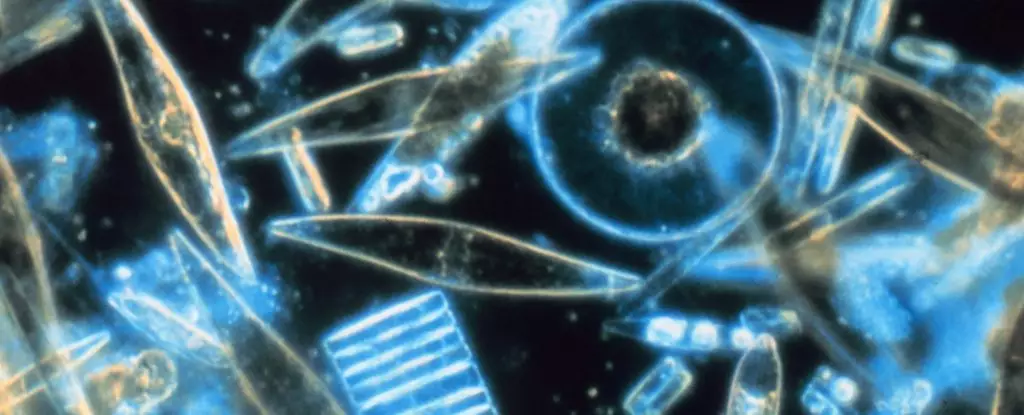The Southern Ocean, long viewed as a distant and relatively static body of water, continues to surprise scientists with its complex and dynamic ecological processes. The recent discoveries of a peculiar turquoise patch—shimmering amid the murky blues and greys—serve as a stark reminder of how little we truly understand about our planet’s critical carbon sinks. For decades, scientists relied heavily on satellite imagery to infer the presence of coccolithophores and their role in sequestering atmospheric carbon. However, recent field studies challenge these assumptions, exposing the possibility that our climate models may be based on incomplete or even misleading interpretations. This guardianship of ignorance is a dangerous oversight that warrants urgent scrutiny.
What makes these waters particularly intriguing is the unexpected presence of coccolithophores, microorganisms traditionally associated with warmer, sunlit environments. Their capacity to produce calcium carbonate scales—coccoliths—contributes significantly to the ocean’s reflectivity and, by extension, influences global carbon cycling. Previously, their presence was believed to be limited to regions where conditions were favorable—warmer waters closer to the equator. The discovery of them thriving in frigid southern waters indicates that the biological narrative governing oceanic carbon sequestration is more nuanced than previously assumed. Such findings unequivocally refute simplistic models that position cold, nutrient-rich waters as mere corridors for diatom proliferation, relegating coccolithophores to tropical or temperate zones. The implications are profound: the southern ocean’s role in buffering climate change could be vastly underestimated, if not misunderstood entirely.
This challenge to established knowledge stems from the limitations of satellite technology, which primarily captures surface-level phenomena. Satellite reflectance data-driven estimates of calcite and particulate organic carbon are increasingly being called into question due to the influence of diatom frustules—silica-based shells—that produce similar optical signatures as coccoliths. This overlap in optical properties has led to misidentifications that cast doubt on the validity of previous assessments. High reflectance signals were attributed largely to coccolithophores, but groundbreaking field research has shown them to be predominantly caused by dense diatom populations. These tiny, silica-shielded organisms are often spotted in regions with high nutrient levels, but their optical effects can mimic those of coccolithophores, thus distorting our understanding of biological contributions to carbon cycling.
The realization that diatoms might be the dominant driver of reflectivity in these regions underscores a critical flaw in the way satellite data has been interpreted. The “blue-green” sea patches, once thought to signal a coccolithophore bloom, could very well be the visual signature of enormous diatom assemblages. This misinterpretation is not just a technical slip; it fundamentally reshapes our perception of the ocean’s capacity to absorb and store atmospheric carbon. If diatoms, instead of coccolithophores, play the central role, then the global carbon budget calculations that influence climate policy are likely flawed. The overestimation of inorganic carbon sequestration in these regions might result in policymakers underestimating the urgency of climate mitigation efforts.
Field investigations aboard research vessels like the Roger Revelle are beginning to fill the critical informational gaps left by satellite observations. By venturing into these remote waters and sampling at multiple depths, scientists have uncovered a startling truth: coccolithophores are indeed present far south of their expected ranges, thriving where conditions were thought impossible. Their presence hints at an adaptive resilience that challenges our existing ecological dogmas. Nonetheless, the dominance of diatoms in these regions signals that our models must evolve; we can no longer rely solely on surface observations or assumptions based on typical geographic niches. Such revelations emphasize the importance of ground-truthing remote sensing data—an essential step toward accurate climate predictions.
Perhaps most troubling is the potential consequence of misidentifying these microorganisms at a global scale. If satellite data has been consistently attributing reflectance signals to coccolithophores, but in reality, diatoms are the primary contributors, then the entire framework of how we estimate the ocean’s biological carbon pump needs reevaluation. This fundamental misunderstanding has far-reaching impacts: policy decisions, climate forecasting, and our collective understanding of Earth’s natural climate regulation mechanisms depend heavily on such data. A recalibration of these models is overdue—not an option but a necessity—if we are to develop a truthful picture of our planet’s environmental health.
In essence, the Southern Ocean’s secrets are a mirror reflecting the broader challenge of scientific humility. Our technological tools are powerful but fallible; our interpretations are often provisional, contingent on limited data and predefined assumptions. The recent research underscores a deeper truth: the ocean’s role in climate regulation is more intricate than a straightforward biological or chemical process. It involves a web of interactions, adaptations, and perhaps unseen players. Recognizing and correcting these misconceptions is not just an academic exercise but a moral imperative—one that influences the future of our climate stability and the vital ecosystems that sustain life on Earth.


Leave a Reply